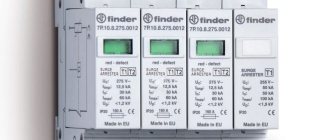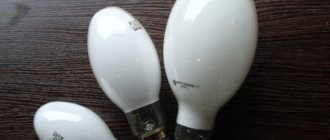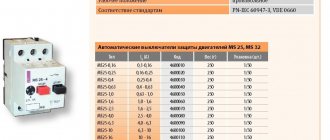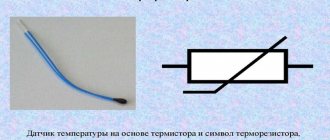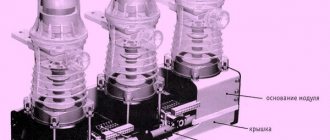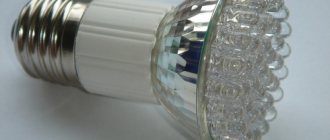Surge suppressors - surge voltage of atmospheric origin is the main cause of failure of electronic equipment and production downtime. The most dangerous type of surge is caused by direct lightning strikes.
In fact, lightning creates current peaks that generate overvoltages in power and data networks, the consequences of which can be extremely undesirable and dangerous for systems, structures and people. Surge arresters have many applications, from protecting a home to a utility substation.
They are installed on circuit breakers inside a residential building, inside built-in transformers, on pole transformers, on pole racks and substations. In this publication we will tell you how to properly connect surge suppressors and show connection diagrams. In particular, here we will talk about the specific device OIN-1.
Why is OIN-1 needed and its functionality?
The surge voltage limiter device is primarily needed to protect the 380/220v AC electrical network. Jumping, pulse voltages, many times higher than the standard values, can occur due to lightning discharges.
In addition, the current mains voltage may change as a result of current surges in the electrical network. They usually occur when connecting to the network or disconnecting any powerful electrical devices.
The circuit of the OIN-1 device includes a powerful varistor that performs the functions of a spark gap, which were used in devices of an older generation.
In this embodiment, the device is connected to the protected electrical circuit in a parallel circuit.
In the event of any emergency situations that arise, when the standard voltage begins to periodically “jump” to a critical level, then the protection device will instantly operate.
What kind of lighting do you prefer?
Built-in Chandelier
During operation of the OIN-1, it may become damaged; to ensure its serviceability, you need to rely on the readings of the built-in indicator. If the indicator is displayed in green, then the device is in working condition, and if the indicator turns red, then the protection device must be replaced.
Area of use
The protective voltage limiter OIN-1 is in great demand when installing electrical networks; it is almost always installed in distribution panels at the entrance to the premises. And it is connected to the circuit directly in front of the electricity meter, that is, the meter itself will be protected from overvoltage.
In addition, this device is used for surge protection, ranging from a residential building to a utility substation. They are installed on circuit breakers inside residential premises, inside built-in transformers, on pole transformers, on pole racks and substations.
Technical specifications
| № | Table of main characteristics of SIN-1: | Meaning |
| 1 | Standard voltage | 220 V |
| 2 | Rated discharge current | 6 |
| 3 | Maximum RT | 13 |
| 4 | Residual stress | 2200 |
| 5 | Protection level | not lower than IP21 |
| 6 | Temperature | from -50 to +55 |
| 7 | Device parameters (dimensions) | 80 × 17,5 × 66,5 |
| 8 | Weight | 0.12 kg |
| 9 | Life time | 3–3.5 years |
| № | Table of main characteristics of SIN-1: | Meaning |
| 1 | Standard voltage | 220 V |
| 2 | Rated discharge current | 6 |
| 3 | Maximum RT | 13 |
| 4 | Residual stress | 2200 |
| 5 | Protection level | not lower than IP21 |
| 6 | Temperature | from -50 to +55 |
| 7 | Device parameters (dimensions) | 80 × 17,5 × 66,5 |
| 8 | Weight | 0.12 kg |
| 9 | Life time | 3–3.5 years |
Expert opinion
It-Technology, Electrical power and electronics specialist
Ask questions to the “Specialist for modernization of energy generation systems”
Surge suppressors OPS-1 The power supply of the security fire alarm system must be uninterrupted and ensure the operation of the alarm system during a network outage in standby mode for at least 24 hours. Ask, I'm in touch!
Surge suppressors - how to connect the device
There are connection diagrams for both one phase and three phases. In addition to the OIN-1 device described here, there are many identical protective voltage limiters from different brands, so the principle of their connection is no different from each other. The typical circuit presented below can practically be used with any type of device.
In the first option, the device is connected to the circuit according to a parallel connection scheme, the second option shows a connection in series with a disconnector. It follows from this that when the surge suppressor operates with a sharp increase in the mains voltage, the disconnector will open the supply circuit.
Attention! In addition to the correct installation of the phase and grounding cables, the cross-section and length of the installation wire are of significant importance.
From the connection point on the terminal block of the device to the grounding bus, the length of the installation wire should not be more than 500 mm.
What needs to be installed in front of the protection device - a circuit breaker or a fuse
To ensure a guaranteed supply of electricity to the room, you need to install a circuit breaker to correctly turn off the SPD, and for reliability you can also use a fuse.
From all of the above, the following conclusion is formed: it is advisable to install surge suppressors in both industrial consumption networks and home electrical networks. Such protection will help you avoid ignition of the installed equipment, and therefore a fire.
Surge voltage limiter. How to connect correctly.
1.7. Lightning arresters OPS1.
PURPOSE OF THE PRODUCT.
Russia has long-distance low-voltage overhead distribution networks that are susceptible to lightning strikes.
In the summer, a lightning discharge into an overhead line causes the appearance of overvoltages of tens of kilovolts, which are in the nature of traveling waves with a high steepness and a rise time from zero to a maximum of 1.0^-8.0 μs and a duration of up to 350 μs. Since networks, as a rule, are not equipped with an effective lightning surge protection system, lightning discharges entering the network can cause breakdown and fire of electrical equipment insulation at significant distances from the discharge site and, accordingly, failure of electrical household appliances (computers, televisions, refrigerators and etc.). A simple and effective way to protect consumers from lightning surges (introduced in most European countries) is the use of lightning arresters. The zone from the substation to the end consumer is divided into 4 sections, the first is protected by gas and vacuum arresters. The remaining three are solid-state varistor dischargers of classes B, C and D, the parameters of which make it possible to gradually reduce the discharge energy at the consumer input to a safe value.
DESCRIPTION.
IEK lightning arresters are varistor arresters of classes B, C and D with replaceable protection modules and visual monitoring with a mechanical indicator of the degree of “wear” of the varistor. The arrester matches the design of the circuit breakers. Structurally, it consists of two parts: a base with connecting clamps and a plate with a threaded hole for connecting the grounding conductor. The middle part of the housing has a rectangular cutout into which a varistor replaceable module is inserted along guides. The module has side plate terminals that fit into the inner part of the connecting clamps.
Inside the module housing there are two disk varistors and a simple mechanism for indicating the degree of “wear” of the varistors from lightning overvoltages. The varistor is a zinc carbide composite. It has the property of almost instantly reducing its resistance by thousands of times when a voltage exceeding the maximum permissible value appears at its terminals. Due to its size and weight, a varistor is capable of dissipating significant energy during a lightning discharge. Being connected in sections in parallel through the inductance of wire and cable lines, varistors divide the lightning discharge energy into parts and absorb it.
OPERATING PRINCIPLE.
When the control handle is moved from the “OFF” position to the “ON” position, the circuit is closed via a bridge contact.
OVERALL AND INSTALLATION DIMENSIONS.
SELECTION AND INSTALLATION.
There are two standard values for the rise time/duration ratio for assessing exposure and calculating protection against atmospheric surges.
Despite its short duration, a lightning discharge carries significant energy. The maximum peak value of the discharge current into the line can reach 100 kA.
To minimize damage from atmospheric overvoltages, a four-stage protection system has been developed using gas and varistor (solid-state) arresters of classes A, B, C and D.
The system allows you to smoothly reduce a dangerous overvoltage impulse “along the way” towards the consumer to a safe value by selecting part of the energy by fast-acting arresters of each stage.
When installing arresters, it should be taken into account that consistent and effective operation of the protection will be ensured if the distance between the stages along the overhead and cable circuits is 7-10 m. In this case, when a traveling discharge wave appears, the inductance of the circuit sections will create the necessary delay time constant. The distance from the arresters installed in the consumer's subscriber panel to the most remote load should not exceed 30 m.
The arresters are installed on a 35 mm mounting DIN rail together with other switching and protective devices. Connection to phase buses is carried out before the residual current equipment, if it does not have the index “S”, i.e. not a selective design. The length of the conductors connecting the arresters to the PEN or PE conductor must be minimal, and their cross-section must be at least 25 mm2.
Purpose of SPD
Surge protection device (SPD) is a device designed to protect the electrical network and electrical equipment from overvoltages that can be caused by direct or indirect lightning effects, as well as transient processes in the electrical network itself.
In other words, SPDs perform the following functions :
— Protection against lightning strikes of the electrical network and equipment, i.e. protection against overvoltage caused by direct or indirect lightning effects
— Protection against surge voltages caused by switching transients in the network associated with turning on or off electrical equipment with a large inductive load, such as power or welding transformers, powerful electric motors, etc.
— Protection against remote short circuit (i.e. against overvoltage resulting from an existing short circuit)
Specifications
No description of devices is complete without information about technical characteristics. OIN-1 has the following characteristics:
- Withstands voltage up to 275V for a long time, at a standard frequency of 50 Hz.
- Installed on DIN rail.
- The width is 17.5 mm, which coincides with the dimensions of a single-pole circuit breaker.
- During operation, it consumes a current of 0.7 mA at 275V.
- It complies with GOST standards and has been certified, so it can withstand pulses up to 10 kV, with Is = 5000A.
- There is a version OIN-1S, equipped with a light indicator for the presence of voltage in the network.
- Terminal blocks allow you to connect current-carrying conductors from 4 to 16 mm.
Expert opinion
It-Technology, Electrical power and electronics specialist
Ask questions to the “Specialist for modernization of energy generation systems”
The structure and principle of operation of an SPD If the indicator is displayed in green, then the device is in working condition, and if the indicator turns red, then the protection device must be replaced. Ask, I'm in touch!
Explanation of the abbreviation and basic operating principle
OPS-1 stands for in electrical engineering as a system surge suppressor. The device works simply. Often acts as a fire alarm.
Abbreviation
The main element of the unit is a varistor, which is a special electrical conductor. Passes electric current through itself, which has increased many times over the rated voltage. As a result, the load is shunted, transformed and dissipated. Thermal energy or heating of the housing is created. In most cases, there is a window through which you can visually determine the performance of the varistor. This device also has a fuse designed to protect equipment from overcurrents.
Important Note
We looked at why OIN-1 is needed and how to install it. But it is imperative to add a note from the official documentation:
We are talking about connecting the machine to the break in the supply wire in front of the limiter. This is necessary in order to break the circuits in the event of a short circuit in the pulse limiter and prevent the negative consequences of the event.
Finally, we recommend watching a video that clearly explains how to connect a surge voltage limiter to the network:
This is where we finish the description of the characteristics and rules for connecting OIN-1. We hope that the prepared review was useful and interesting for you!
You probably don't know:
Application area
Let's consider where OIN-1 is used in practice. The use of surge voltage limiters in real work is quite wide. It is installed in input panels or consumer metering panels. At the same time, it is recommended to install it before the meter in order to protect it too. We will talk about how to properly connect OIN-1 to the panel below.
If you are going to build a house and connect the site to electricity, the technical specifications for the connection will indicate the need to install a surge protection device. But such a requirement is introduced in most cases as specified in the PUE - when introducing aerial cables.
Official documentation on the use of a surge voltage limiter refers to the fact that its use in TN-S, TN-CS grounding systems in single-phase and three-phase networks is recommended.
Build process
Now it’s time to figure out how to assemble a 220 V metering panel. You only need to carry out the assembly according to the diagram. We remind you once again that if you do not know how to assemble, then it is better to turn to professionals. Below is an assembly diagram that includes an RCD and an OPS.
Electricity metering panel diagram with RCD and OPS
The installation should begin with the introductory machine. Then, in parallel with the introductory machine, you need to install an alarm system. This device must be additionally grounded. Then the phase and neutral wires will go to the meter, and from the meter to the RCD. From the RCD, the phase will be connected through all groups of machines, and the “zero” wire goes to the zero bus. Groups of machines can be connected to each other by a special bus or jumpers. All that remains is to connect “BA” with the power wire.
Now you know how to select and assemble a metering panel. It is necessary to tighten the contacts with maximum force, as they may become loose over time.
Source
Counter selection
All meters can be divided into mechanical and electronic. The first type is the most common and is now installed in most houses and apartments. The electronic meter is equipped with a liquid crystal display on which all readings are displayed. Its error can be up to 1%. Now many models are equipped with additional functions that simplify the process of use.
Design of the meter TsE6803V
This type can also be divided into single-tariff and double-tariff models. The second option considers electricity at two tariffs, therefore it is much more profitable. Another criterion is the accuracy class, but there is no need to focus your attention on it. Counter sizes may vary. They do not affect performance. However, if you decide to install it in a panel, then it is better to give preference to small models.
Designation on circuit diagrams
The main symbols that are used in the case of overcurrent discharge devices are presented in the following image. The first symbol is a general arrester, the second is a tubular arrester, the third is a valve and magnetic valve arrester, and the last is a surge suppressor.
Designation on the circuit diagram
Number of circuit breakers
Select a shield in which you will install all the elements. Its dimensions depend on the number of circuit breakers that will be installed in the future. Of course, if you wish, you can install a switch for each socket or switch, but this will be unnecessary. If the consumption in the house is large, then 2 rooms can be connected to one pair of machines.
Single pole circuit breaker
If a device in a house consumes more than 5 kilowatts, then it should be connected to a separate line, and accordingly a separate machine. Also, many electricians recommend connecting the washing machine through a separate machine.
Safety and effectiveness of the limiter
Each manufacturer recommends the use of an additional fuse to protect the network in case of damage to the discharge device and in case of a short circuit in the phase wire. In domestic installations, an additional fuse is not needed since overcurrent protection is provided by a single breaker or fuse. One device can protect the network from interruptions.
Limiter efficiency
Purpose and principle of operation
The surge voltage limiter OIN-1 is needed to protect electrical networks with a voltage of 380/220V. These are standard voltages for powering electrical networks. Voltage surges can occur as a result of lightning strikes. Because of them, a potential difference arises in the ground. In addition to them, switching bursts in the network are distinguished. They occur when powerful electrical appliances are turned on or off or a group start of consumers in an electrical installation. Switching pulses can occur when starting powerful electric motors or group starting of pumping stations, as well as when turning on capacitor units.
How does the limiter work? Varistors are installed inside OIN-1. According to the principle of operation, varistors resemble arresters that were used previously. Therefore, the limiter is installed parallel to the protected circuit. If the voltage in the network exceeds the permissible (classification) voltage of the varistor, it begins to short-circuit the wires, thus diverting the danger from electrical appliances connected after it.
Electricity metering panel 220 V
In this article, our website vse-elektrichestvo.ru will tell you how to assemble a 220 V electricity metering panel for a country house. The assembly process is a responsible task, so you must be completely confident in your abilities. If in doubt, then it is better to entrust this work to professionals.
Electricity meter housing
The shield is needed to account for the electricity you consume. Therefore, the main element in the design is the counter. If errors are made during installation, a short circuit may occur. Before starting installation, you first need to draw a preliminary assembly diagram.
How to connect OIN-1 in the panel
This device has a number of functional analogues from all popular electrical equipment manufacturers, therefore their connection diagrams are basically similar. In the official documentation, the connection diagram is not too obvious; it is presented in two versions and looks like this:
Please note the first option is to connect in parallel to the protected circuit, and the second is to connect in series with the disconnector. That is, as a result of the operation of the surge voltage limiter, the disconnector must break the power circuit in order to avoid the product igniting and current flowing through the electric arc.
But the given diagram is not at all clearly or clearly depicted, and the question immediately arises of how to properly install the device. Therefore, check out several examples of connecting an SPD to the electrical network.
The figure below shows a typical diagram of the conditions for connecting 3 phases. The connection of voltage limiters to the meter is shown here more clearly. In a three-phase circuit with a TN-S or TN-CS grounding system, it is connected between phases, neutral and ground. But connecting OIN-1 after the meter is also acceptable as an additional level of protection.
Installation diagram using an example of connection in a two-wire electrical network:
And finally, let's look at the diagrams for four different power supply schemes (1 phase, 3 phases, combined and disconnected protective conductors), which are most common:

